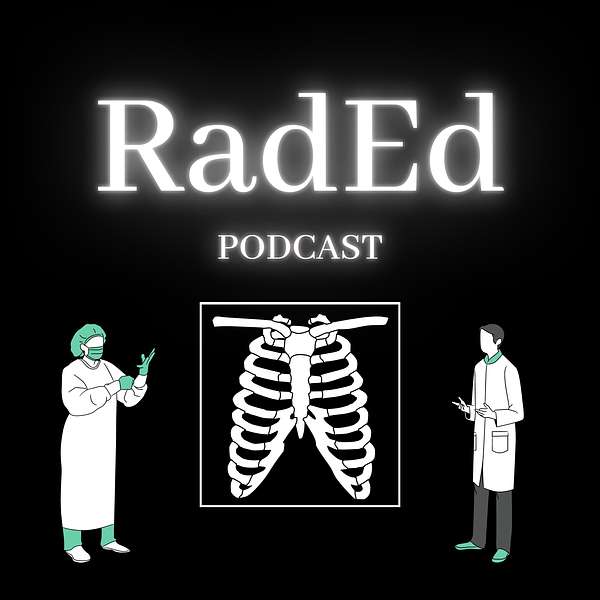
RadEd
This is a podcast about all things radiology designed for medical students, residents, attending radiologists, and anyone else interested! The goal of this podcast is to educate people on and explore the field of radiology. Topics covered include: diagnostic imaging modalities, important radiology concepts/findings, current research topics in the field, technologies and procedures of the field, social and ethical challenges, radiology as a career, interviews with radiologists, and much more!
RadEd
Chest X-Ray: Lung Anatomy
- Understanding normal anatomy is key before being able to understand what is abnormal
- Anatomy review
- Visceral pleura hugs the lungs (forms fissures), parietal pleura lines chest wall
- Lobes of the lung: right lung has upper, middle, and lower lobes, left lung has upper and lower lobes
- Fissures: right lung has horizontal/minor fissure and oblique major fissure, left lung has one huge oblique major fissure
- Invisible or fine white lines, if thickened may represent excess fluid from a process such as congestive heart failure
- Trachea -> carina -> main bronchus -> lobar (secondary) bronchi -> segmental (tertiary) bronchi -> subsegmental bronchi -> bronchioles -> secondary lobules (centrilobular artery and bronchus) -> respiratory bronchioles -> alveoli
- Cannot usually see bronchi on chest x-ray
- Conduction zone = trachea, bronchi, bronchioles, terminal bronchioles
- Respiratory zone = respiratory bronchioles, alveolar ducts, alveoli
- Lung parenchyma = alveoli, ducts, and respiratory bronchioles
- Type 1 pneumocytes do gas exchange, type 2 pneumocytes produce surfactant, alveolar macrophages ingest and process debris
- Hemidiaphragms: left is obscured by heart, on lateral radiograph can follow the right hemi all the way across
- Left main pulmonary artery arches over the left main bronchus
- The right pulmonary artery will be anterior and inferior to the bronchus/left pulmonary artery on lateral radiograph
- Each pulmonary artery may appear as slightly opaque compared to the lumen of the bronchus
- Pulmonary vessel markings taper peripherally and will show up as white lines thicker at the base of the lung
- Lungs have supply from pulmonary arteries and bronchial arteries (from aorta)
- Pulmonary veins drain into left atrium
- Innervation: parasympathetic from vagus, sympathetic from thoracic ganglia
- Lymph drainage goes to hilum
- Physiology: parasympathetic causes vasoconstriction, bronchoconstriction, gland secretion, sympathetic does opposite and opens things up
- Lateral radiograph is important to view areas of the lung that may not be obviously abnormal on frontal view
- Normal features of lateral radiograph:
- Space behind the sternum (lack of could point to mediastinal masses)
- Absence of a major shadow from the hila (presence could point to sarcoidosis)
- Consistent height of vertebrae
- Sharp posterior (requires less fluid to visualize) costophrenic angles (blunted/opacity filled could point to pleural effusion)
- Continuous right hemidiaphragm (and slightly higher)
- Normal features of lateral radiograph:
- As with all studies/indications, when looking at an image, do not forget to look at all of the structures in field of view; even if you are reading a chest x-ray to rule out pneumonia/pneumothorax, remember to view all of the other structures, such as the thoracic vertebrae!
References: Herring's Learning Radiology, Radiopaedia, Mandell's CORE Radiology